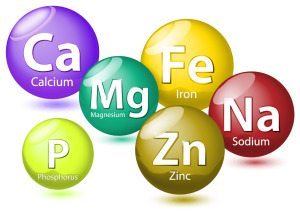
Our lifestyle is impacting our dietary choices
The lifestyle of Indians is noticeably changing. Rapid urbanization, coupled with industrialization and the fast-pace of life is having an impact on our dietary preferences. With the rapid increase in the number of working women, there is very little time at hand to devote for food preparation. Therefore, there is greater dependence on processed food. In these types of food, the likelihood of losing the nutrient content increases appreciably. This underscores the need for fortification, which makes up for any losses during food processing.
Why are minerals important in our diet?
Minerals are naturally occurring inorganic elements with a definite chemical composition. More than 50 chemical elements are found in the human body, which are required for growth, repair and regulation of vital body functions. The major minerals include calcium, phosphorus, sodium, potassium and magnesium. The trace elements are required in quantities of less than a few milligrams per day e.g. iron, iodine, fluoride, zinc, copper, cobalt, chromium, manganese, molybdenum, selenium, nickel, tin, silicon and vanadium.
There are some trace contaminants with no known function e.g. lead, mercury, barium, boron and aluminium. The daily requirement of minerals by the human body varies from grams for sodium and potassium, through milligrams per day (e.g. iron, zinc), to micrograms per day for many of the trace elements. Many of the essential minerals are widely distributed in foods. However, the same may not be true for processed food, as many vital minerals may be lost during food processing. Hence, the need for fortification.
Table 1: Importance of minerals in the diet
| Mineral | Sources | Recommended dietary allowance (RDA) | Health implications |
|---|---|---|---|
| Calcium | Milk and milk products, bony fish, green vegetables, beans | 700 mg | Deficiency can cause osteomalacia. Excess can cause constipation and toxicity |
| Phosphorus | Milk, cereals, bread, meat | 550 mg | Deficiency causes hypophosphatemia and muscle weakness |
| Magnesium | Whole grain foods, nuts | 300 mg (men) 270 mg (women) | Regulates hormone action |
| Iron | Liver, meat, vegetables, wholemeal bread | 8.7 mg 14.8 mg (women <50 yrs) | Deficiency causes anemia. Excess causes hemochromatosis and hemosiderosis |
| Zinc | Red meat, dairy products, wholemeal bread | 9.5 mg (men) 7 mg (women) | Deficiency can cause dwarfism and hypogonadism |
| Iodine | Milk and dairy products | 140 µg | Deficiency causes goitre |
| Selenium | Fish, wheat grown in selenium-rich soils | 75 µg (men) 60 µg (women) | Deficiency can cause hypothyroidism, cardiomyopathy (children), myopathy (adults). Excess causes selenosis |
| Copper | Liver, bread, cereals, vegetables | 1.2 mg | Deficiency occurs only in children. Causes microcytic hypochromic anemia, neutropenia, retarded growth, weak bones. Excess causes Wilson’s disease |
| Fluoride | Fluoride treated drinking water, tea | 0.5 mg/kg | Prevents dental caries. Excess causes fluorosis |
| Potassium | Dried and fresh fruits, potatoes, coffee, vegetables, milk | 3.5 g | Deficiency can lead to hypokalemia |
| Sodium | Table salt, bread, processed foods | 1.6 g | Deficiency can lead to hyponatremia |
Adapted from Davidson’s Principles & Practice of Medicine, 21st Edition, 2010. Edinburgh: Churchill Livingstone Elsevier.
Which foods are commonly fortified with minerals?
Many foods nowadays are fortified with minerals. Some of the staple foods that are fortified include rice (extruded rice flour reconstituted), edible flour (wheat flour, maize flour), edible oils (vegetable oils, margarine, Vanaspati), iodized table salt and milk (liquid milk, infant milk powder). Some of the processed foods that are fortified include fruit juices, nectars, powered soft drink concentrates, breakfast cereals (corn flakes), noodles, pasta, jams, jellies, seasonings, biscuits, breads, confectionery and milk products (yogurt, flavored milk, ice cream).
What is FSSAI’s take on mineral fortified food?
The FSSAI Food Safety and Standards (Food Products Standards and Food Additives) Regulation, 2011 approve the use of minerals for food fortification purposes within recommended limits. For example, the FSSAI recommends that infant milk food should be fortified with minerals such as calcium, phosphorus, chloride, iron, magnesium, sodium, potassium, copper, iodine, zinc, and manganese. FSSAI also recommends that milk-cereal based complementary food, which is intended to supplement the diet of infants after the age of six months, should contain minerals such as calcium, phosphorus, chloride, iron, magnesium, sodium, and zinc, but not the others that are present in the infant milk food.
It also specifies that fruit based beverage mix/powdered fruit based beverage can be fortified with minerals. Pasta products, such as macaroni, spaghetti and vermicelli can contain permitted minerals. Malt and malt based foods can also contain minerals. It is also recommended that various types of sweets and confectionery can be fortified with minerals. Therefore, it is quite evident that FSSAI, India’s apex food authority, supports mineral fortification for a large number of food products. It follows that since minerals are recommended for infant food formulations, they are not only safe, but also a necessary component of food.
What are the future challenges?
From the foregoing discussion, it is evident that minerals are an important component of food and that fortified foods are here to stay. Therefore, there is a need to create community awareness about the benefits of food fortification on improvement of health in general. The private sector, government, and international agencies need to make commitments for investing in food fortification.
The government should ensure that adequate supply of fortified foods are available to the vulnerable and malnourished populations. Governments and international agencies should encourage food processors to take up food fortification of their products by way of tax concessions or duty rebates. Regulatory authorities like CODEX Alimentarius in different geographical regions should recommend Uniform Food Fortification Guidelines to the member countries. Finally, there is a need to develop new and novel technologies to produce futuristic foods.
FSSAI has recently issues a draft Regulation on Food Fortificaton.
daniel Jogal says
Is it as per codex or there are limits.